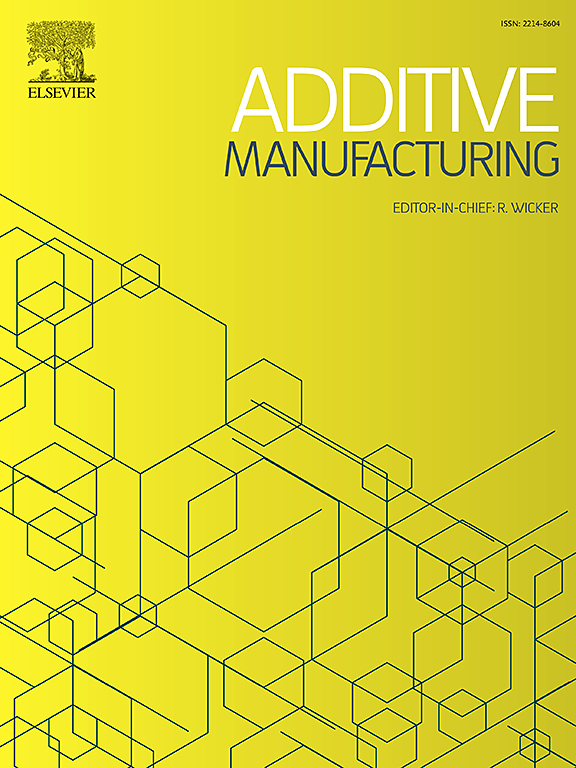Identifying melt pool behavior in ceramics PBF-LB via operando synchrotron tomographic microscopy and high-fidelity process modeling
IF 10.3
1区 工程技术
Q1 ENGINEERING, MANUFACTURING
引用次数: 0
Abstract
Recent advancements in high-fidelity process simulations have significantly enhanced the understanding of melt pool behavior during laser-based powder bed fusion (PBF-LB) of metals. However, for ceramics, their unique material properties and complex thermophysical behavior present significant challenges in developing detailed models that effectively complement limited experimental observations. In this work, we integrate operando synchrotron X-ray tomographic microscopy with computational fluid dynamics-discrete element method (CFD-DEM) simulations to investigate the melt pool dynamics of alumina during PBF-LB. In-situ observations reveal a shallow and wide melt pool, distinct from that of metals. This behavior is linked to alumina’s low thermal conductivity, high laser absorption, and negative surface tension gradients, as confirmed through high-fidelity process simulations. Key mechanisms identified include limited heat penetration, enhanced surface-oriented convection, and surface vortices driven by heat exchange with the surrounding gas environment. The influence of laser power and scanning speed on melt pool geometry is systematically analyzed, leading to the first virtual process map and parameter windows for stable PBF-LB of alumina. These findings provide critical insights for optimizing process parameters and advancing ceramic additive manufacturing.
利用同步加速器层析显微镜和高保真过程建模识别PBF-LB陶瓷熔池行为
高保真过程模拟的最新进展大大提高了对基于激光的粉末床熔合(PBF-LB)金属熔池行为的理解。然而,对于陶瓷而言,其独特的材料特性和复杂的热物理行为在开发详细模型以有效补充有限的实验观察方面提出了重大挑战。在这项工作中,我们将operando同步加速器x射线层析显微镜与计算流体动力学-离散元法(CFD-DEM)模拟相结合,研究了PBF-LB过程中氧化铝的熔池动力学。现场观测显示了一个浅而宽的熔池,不同于金属熔池。这种行为与氧化铝的低导热性、高激光吸收和负表面张力梯度有关,这一点通过高保真工艺模拟得到了证实。确定的关键机制包括有限的热渗透,增强的表面对流,以及由与周围气体环境的热交换驱动的表面涡。系统分析了激光功率和扫描速度对熔池几何形状的影响,得到了氧化铝稳定PBF-LB的第一个虚拟工艺图和参数窗口。这些发现为优化工艺参数和推进陶瓷增材制造提供了重要见解。
本文章由计算机程序翻译,如有差异,请以英文原文为准。
求助全文
约1分钟内获得全文
求助全文
来源期刊

Additive manufacturing
Materials Science-General Materials Science
CiteScore
19.80
自引率
12.70%
发文量
648
审稿时长
35 days
期刊介绍:
Additive Manufacturing stands as a peer-reviewed journal dedicated to delivering high-quality research papers and reviews in the field of additive manufacturing, serving both academia and industry leaders. The journal's objective is to recognize the innovative essence of additive manufacturing and its diverse applications, providing a comprehensive overview of current developments and future prospects.
The transformative potential of additive manufacturing technologies in product design and manufacturing is poised to disrupt traditional approaches. In response to this paradigm shift, a distinctive and comprehensive publication outlet was essential. Additive Manufacturing fulfills this need, offering a platform for engineers, materials scientists, and practitioners across academia and various industries to document and share innovations in these evolving technologies.
 求助内容:
求助内容: 应助结果提醒方式:
应助结果提醒方式:


